Wall Painting Tradition in India: Creating Giant Wall Art with the Local Villagers
Akiko Ookuni
NPO Wall Art Project
Bihar is one of the states in India with a particularly poor educational environment and a literacy rate of only just over 50% according to a survey conducted in 2011. Bodh Gaya in southern Bihar is where Buddha reached enlightenment, a city always bustling with pilgrims from all over the world. Monks in yellow-orange or dark red robes walk along the roads, wearing masks, perhaps because of the excessive exhaust fumes and dust. The 800-meter wide Niranjana River runs between Bodh Gaya and its nearby villages, and the usually tumultuous river dries up in the February dry season to provide the perfect playground for children. It is here on this dry riverbed that the artist Ichiro Endo and his team fly their magnificent kites in an art performance that heightens the excitement of the Wall Art Festival.
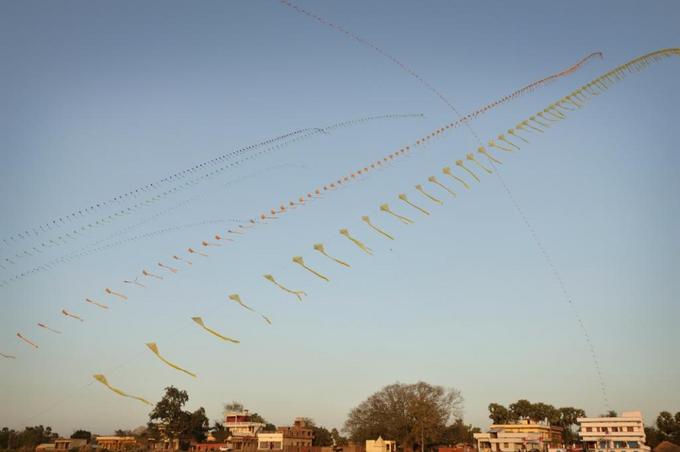
Future Dragon India Big Sky Kite 2: Dream is flying over the rainbow 2 by Ichiro Endo and his kite team. The 1,080 multi-colored kites marked a record number of linked kites. Launched at Ichiro Endo's rallying cry, "Go for future!"
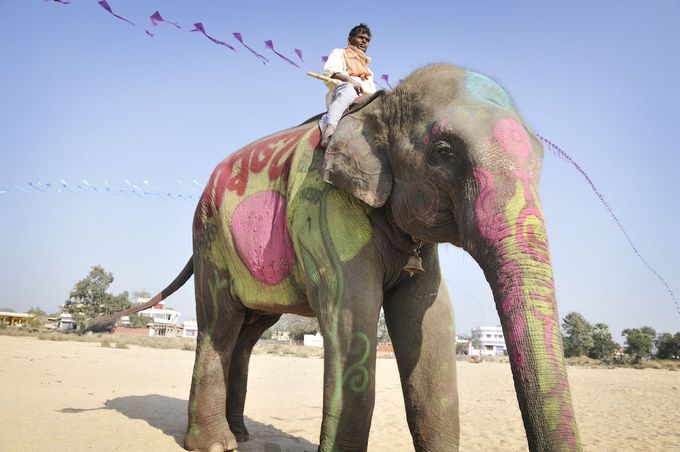
Mirai e zo (Elephant for Future) by Ichiro Endo and Yusuke Asai. In India, elephants are considered sacred animals and it is customary to paint them during festivals. Using the same dyes, Ichiro Endo painted a sun, a moon, and the words "go for future" in Hindi, and Yusuke Asai painted pictures of plants.
In the kite project, Endo asked the children and villagers to draw their dreams for the future on kites which were then linked together and flown high in the sky. The kites were to be flown at 4 pm, and when the time came, nearly 100 villagers would suddenly appear out of nowhere to lend a hand. This project may seem to be a glamorous event at first glance, but the actual work also involves the meticulous process of spreading out the train of 100 kites and getting them into place beforehand, and then carefully stacking them into piles to stow them away afterwards. It teaches the lesson that art is actually a lot of hard work.
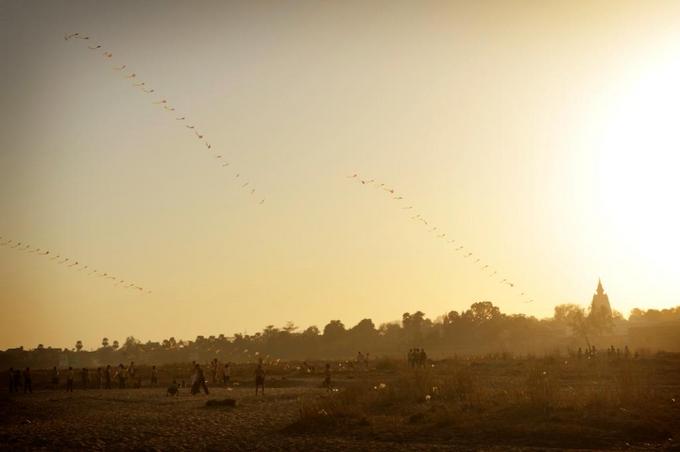
From about two weeks before the festival, the kites were flown every day from 4 pm to sunset, as the World Heritage site Mahabodhi Temple was silhouetted against the skyline.
The WAF is an art festival held at a school in a quiet rural area across the bridge from Bodh Gaya, and celebrates its third year this February. It all started in 2006 when 50 Tokyo Gakugei University students donated money they made from working part-time jobs to an NGO in India to construct a new school building for the Niranjana Public Welfare School in Bihar. But they did not stop there. They realized how important it was to provide ongoing support, and came up with the idea of holding an art festival that would use the white walls of the school as a canvas. This was support in the form of an idea, suggesting a use of the walls that the local people had not noticed. I happened to become acquainted with these students since I had been a PTA leader at my son's elementary school, and became friends with the principal of the Niranjana School, and these connections eventually led to the WAF events being held at the Niranjana School.
The Wall Art Project, the organizing body of the WAF, first started out with the smallest group of people possible. We only had two people: one of them was myself in Japan, and the other was a student in India, Kazunori Hamao, better known as "Okazukun", who organized the operating committee with other young people in India. How did such a small project develop into an art festival of this magnitude, with more than 50 volunteers from Japan and 3,200 visitors in three days? Many people have asked me this question, but I hope to talk about this at a later opportunity when we will be reporting on our activities* with the artists.
Yusuke Asai has participated in all three WAF events, and each time his artwork seems to have navigated the future path of the WAF. He has produced paintings using only the local soil and water, introducing a new way to appreciate the earth that the villagers are familiar with through farming.
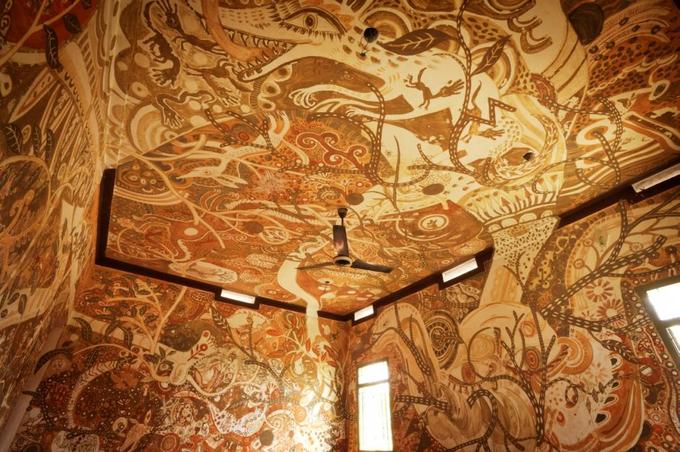
Doroe: Yaoyorozu no monogatari (Mud painting: Countless Stories, Living Boldly, Repeat) by Yusuke Asai
Soil, straw ash, water, and straw from around Sujata Village
Walls and ceiling of a classroom 630 cm long x 415 cm wide x 310 cm high
Because the venue is a school and we felt the paintings should be regarded purely as art, we decided in consultation with the artists that once the festival was over the paintings should be erased. In 2012, after the art work was exhibited only for the three days of the WAF, a workshop was held with the children to erase the paintings. When mud paintings are erased, they return to the soil. Through this experience, Asai was teaching the children the meaning of life as a cycle in today's context, by painfully wiping away his own work.
But Asai, seeking a way to make his work last, came up with the idea of holding a workshop where the children could add drawings of themselves within the work and create a story from the pictures. Studying within walls covered in paintings is a rare art experience in itself. But the chance to weave a story with paintings that are soon to disappear and getting involved in the act of art was surely a memorable experience that will leave a lasting impression on their hearts.
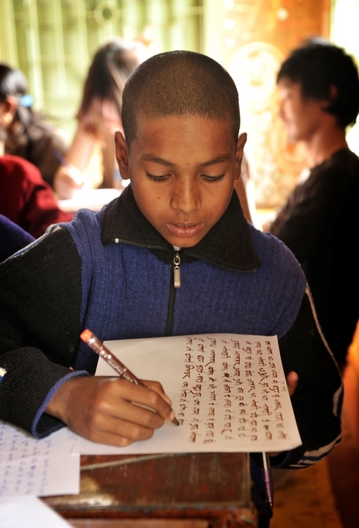
A child diligently writing a story at the workshop
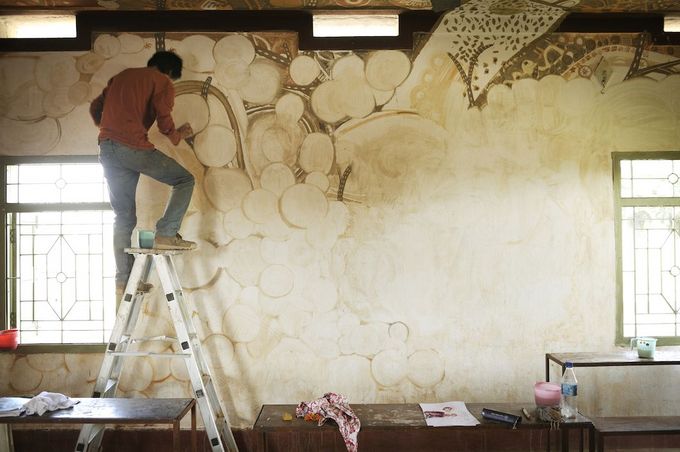
Wiping the paintings away with sponges, dissolving the mud and letting it return to ordinary soil
Indian artists were also invited to take part in the festival. WAF 2012 welcomed Alwar Balasubramaniam, known for wall sculpture in the field of fine art, and he made a wondrous sun appear in the classroom using easily accessible material such as charcoal and pen. Rays of light were drawn radiating from this sun in crayon, and a workshop was held to invite children to draw their most precious things along those rays. Balasubramaniam said, "I am like an alien, landing here out of the blue. That's why I wanted to paint with the children together."
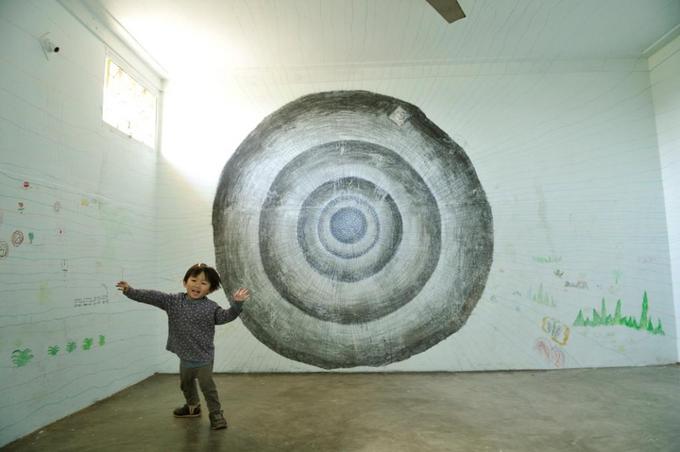
Light River by Alwar Balasubramaniam
Watercolor, marker pen, charcoal, oil pastel, and colored pencil
Four walls and ceiling of a classroom 457 cm long x 366 cm wide x 366 cm high
India has a remarkable tradition of wall paintings. The WAF invited a Mithila painter from Bihar in 2011, and a Warli painter in 2012. Indigenous Warli paintings express the tribe's everyday life, and though they consist of simple circles, triangles, and lines, they seem to be bursting with life. The artist Rajesh Chaitya Vangad painted on a fourth wall his idea of the future for the village children.
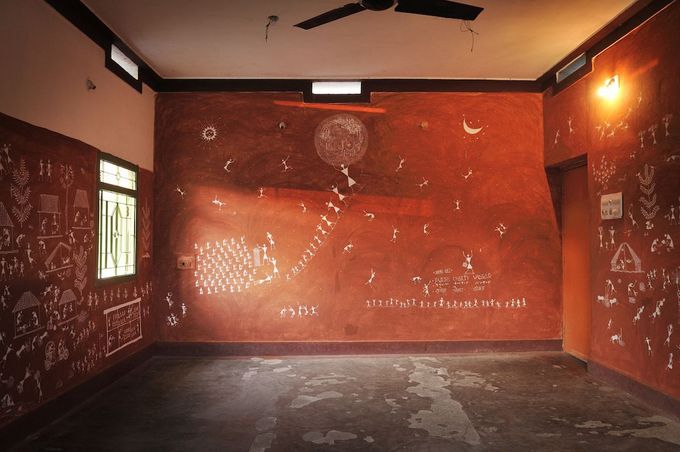
Warli Painting by Rajesh Chaitya Vangad
Red soil, poster color, and fixative
Fourth wall of a classroom 610 cm long x 366 cm wide x 305 cm high
The three goals of the Wall Art Festival are:
1. To demonstrate the power of art to the children and villagers
2. To get people around the world to think about the life of the local children and villagers, through WAF visitors, media coverage, and volunteers
3. To bring attention to the village and revitalize the community, and to link this to the implementation of a better educational system and infrastructure
The WAF has been held in Sujata Village three times now, but next year we will be taking a new step, moving to the home of the Warli. People have asked us why we are leaving Sujata, and we assure them it was not an easy decision. But we have sown the seeds, and believe it is now time for us to patiently wait for them to grow. Our ultimate hope is that the children of Sujata will grow up to become the driving force of the WAF events in the future. We hope that someday we will be working with them again in our quest to move forward.
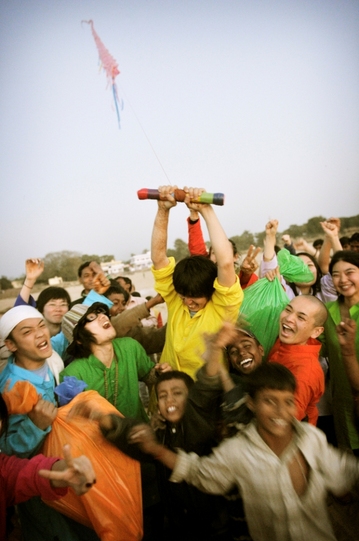
On the last day of the kite project, one of the children said to Endo, "The festival might be over, but "Go For Future" won't end, will it?"
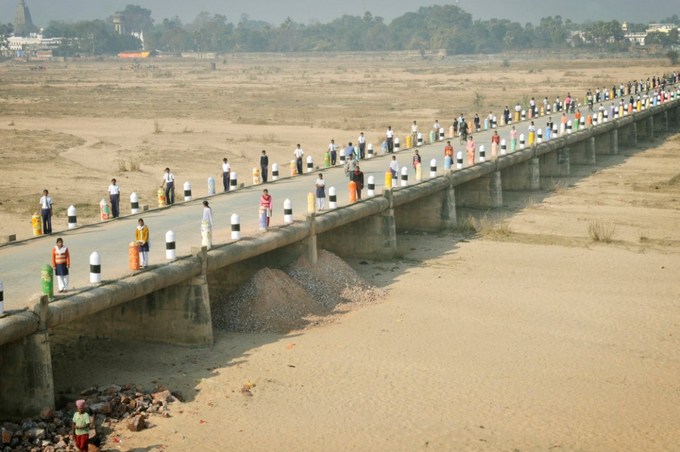
Our Bridge by N. S. Harsha, Oil color
On the 277 pillars of the bridge between Bodh Gaya and Sujata Village (WAF 2011)
*A workshop was held with the children drawing their "dream village" that they had imagined beforehand onto the pillars.
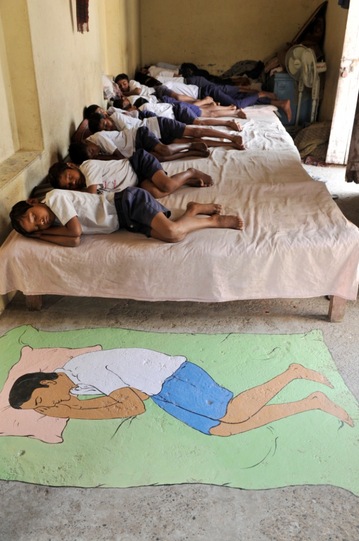
Painting For Good Sleeping by N.S. Harsha
Watercolor, 180 cm long x 100 cm wide (WAF 2011)
On the Niranjana School dormitory floor
Photos by Kenji Mimura
Related event Demonstrating the Power of Art to the Children of India--Wall Art Festival
Time and date: 6:30 pm to 8:30 pm on Wednesday, May 16, 2012 (doors open at 6 pm)
Venue: The Japan Foundation, JFIC
Content: WAF 2012 documentary photo exhibition and documentary film with Ichiro Endo (future artist), Chieko Takasuka (improvisational dance performer), Akiko Ookuni (Wall Art Project producer), Kazunori Hamao (Wall Art Project local coordinator), and others.
http://www.jpf.go.jp/j/about/jfic/event_s/cmp/120516.html
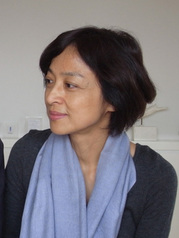 Akiko Ookuni
Akiko Ookuni
Director of the NPO Wall Art Project. Also a freelance writer, producing articles for women's magazines. Began volunteer activities having been a PTA leader at her son's school. Established the WAP, and currently preparing for WAF 2013. The WAF official website: http://wafes.net/
Related Events
Back Issues
- 2022.11. 1 Inner Diversity<3> <…
- 2022.9. 5 Report on the India-…
- 2022.6.24 The 48th Japan Found…
- 2022.6. 7 Beyond Disasters - …
- 2021.3.10 Crossing Borders, En…
- 2020.7.17 A Millennium of Japa…
- 2020.3.23 A Historian Interpre…
- 2019.11.19 Dialogue Driven by S…
- 2019.10. 2 The mediators who bu…
- 2019.6.28 A Look Back at J…

